window Lancia Musa 2009 Owner handbook (in English)
[x] Cancel search | Manufacturer: LANCIA, Model Year: 2009, Model line: Musa, Model: Lancia Musa 2009Pages: 218, PDF Size: 3.7 MB
Page 80 of 218

79
SAFETY
DEVICES
STARTING
AND
DRIVING
WARNING
LIGHTS AND
MESSAGES
IN AN
EMERGENCY
MAINTENANCE
AND CARE
TECHNICALSPECIFICATIONS
INDEX
DASHBOARD
AND CONTROLS
Automatic continuous operation
(where provided)
Some versions feature four power
windows with automatic lifting and
lowering of the front window (driver’s
side) and automatic lowering only of
the other windows.
AButton for continuous auto-
matic opening and closing;
B-C-DButtons for continuous auto-
matic opening only.
By pressing one of the buttons briefly,
the window moves “in pulse mode”
and stops on releasing the button.
PASSENGER’S SIDE DOOR
AND REAR DOORS (where
provided) fig. 104
The switch controlling the corre-
sponding window is located on the in-
ternal armrest of each door.
fig. 104L0D0103m
Incorrect use of the power
windows may be danger-
ous. Before operation, always check
that no-one is exposed to the risk of
being injured by directly by the
moving window or objects getting
caught and dragged. When leaving
the car, always remove the key from
the ignition device to avoid the risk
of injury due to accidental operation
of the power windows.
WARNING
fig. 105L0D0156m
MANUAL (where provided)
To open and to close the window use
the relevant window winderfig. 105.
038-094 MUSA 1ed GB 11-07-2008 14:10 Pagina 79
Page 81 of 218
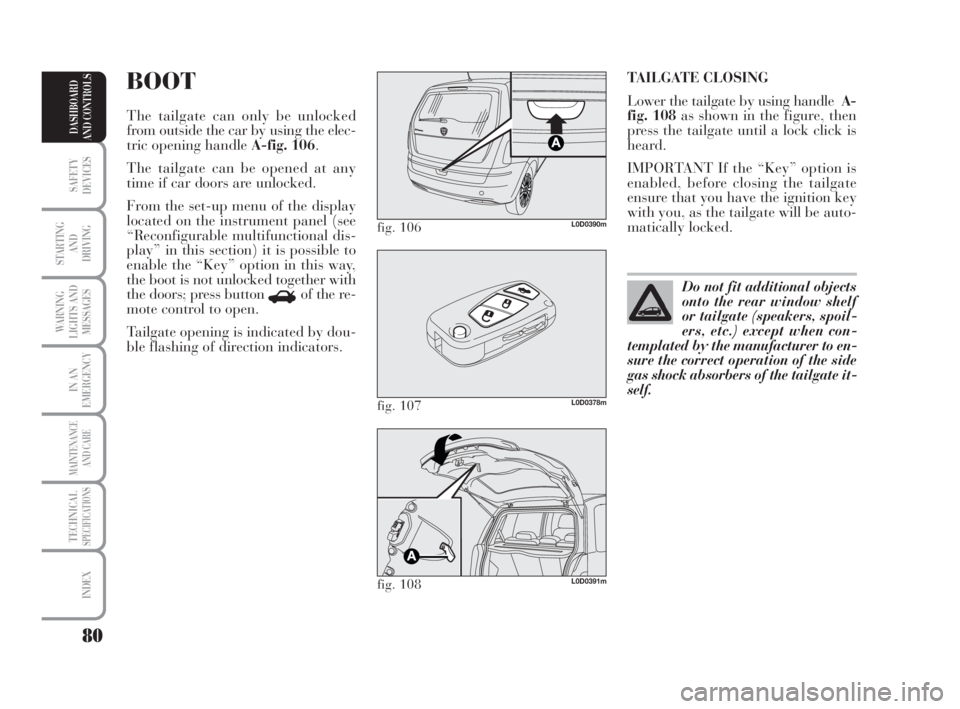
80
SAFETY
DEVICES
STARTING
AND
DRIVING
WARNING
LIGHTS AND
MESSAGES
IN AN
EMERGENCY
MAINTENANCE
AND CARE
TECHNICALSPECIFICATIONS
INDEX
DASHBOARD
AND CONTROLS
TAILGATE CLOSING
Lower the tailgate by using handleA-
fig. 108as shown in the figure, then
press the tailgate until a lock click is
heard.
IMPORTANT If the “Key” option is
enabled, before closing the tailgate
ensure that you have the ignition key
with you, as the tailgate will be auto-
matically locked.BOOT
The tailgate can only be unlocked
from outside the car by using the elec-
tric opening handle A-fig. 106.
The tailgate can be opened at any
time if car doors are unlocked.
From the set-up menu of the display
located on the instrument panel (see
“Reconfigurable multifunctional dis-
play” in this section) it is possible to
enable the “Key” option in this way,
the boot is not unlocked together with
the doors; press button
Rof the re-
mote control to open.
Tailgate opening is indicated by dou-
ble flashing of direction indicators.
fig. 106L0D0390m
fig. 107L0D0378m
fig. 108L0D0391m
Do not fit additional objects
onto the rear window shelf
or tailgate (speakers, spoil-
ers, etc.) except when con-
templated by the manufacturer to en-
sure the correct operation of the side
gas shock absorbers of the tailgate it-
self.
038-094 MUSA 1ed GB 11-07-2008 14:10 Pagina 80
Page 82 of 218
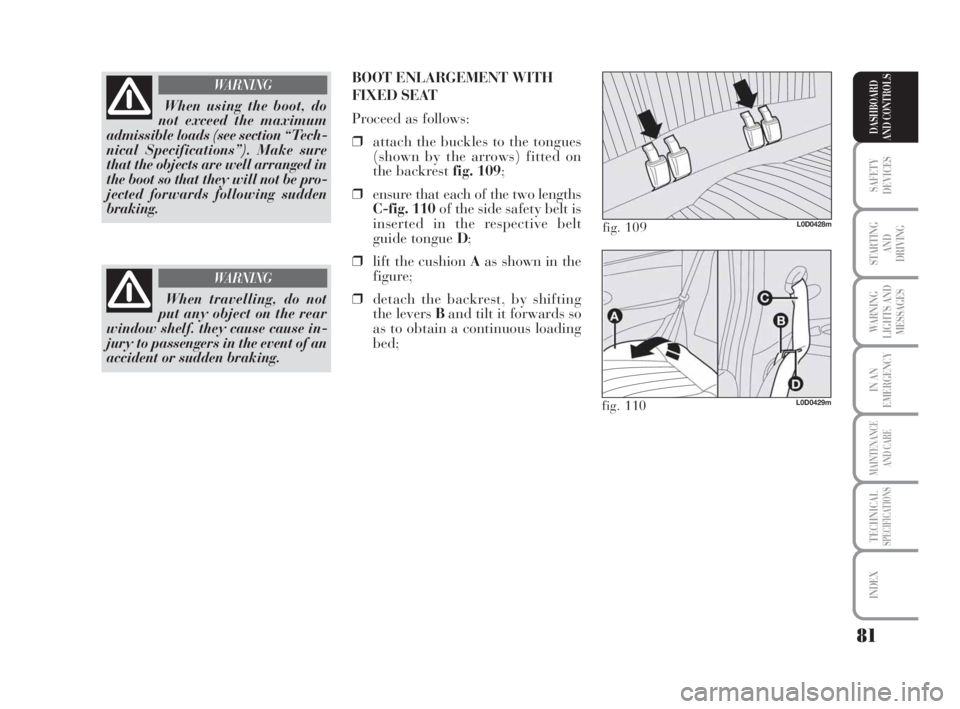
81
SAFETY
DEVICES
STARTING
AND
DRIVING
WARNING
LIGHTS AND
MESSAGES
IN AN
EMERGENCY
MAINTENANCE
AND CARE
TECHNICALSPECIFICATIONS
INDEX
DASHBOARD
AND CONTROLS
When using the boot, do
not exceed the maximum
admissible loads (see section “Tech-
nical Specifications”). Make sure
that the objects are well arranged in
the boot so that they will not be pro-
jected forwards following sudden
braking.
WARNING
When travelling, do not
put any object on the rear
window shelf. they cause cause in-
jury to passengers in the event of an
accident or sudden braking.
WARNING
BOOT ENLARGEMENT WITH
FIXED SEAT
Proceed as follows:
❒attach the buckles to the tongues
(shown by the arrows) fitted on
the backrestfig. 109;
❒ensure that each of the two lengths
C-fig. 110of the side safety belt is
inserted in the respective belt
guide tongue D;
❒lift the cushion Aas shown in the
figure;
❒detach the backrest, by shifting
the levers Band tilt it forwards so
as to obtain a continuous loading
bed;
fig. 109L0D0428m
fig. 110L0D0429m
038-094 MUSA 1ed GB 11-07-2008 14:10 Pagina 81
Page 96 of 218
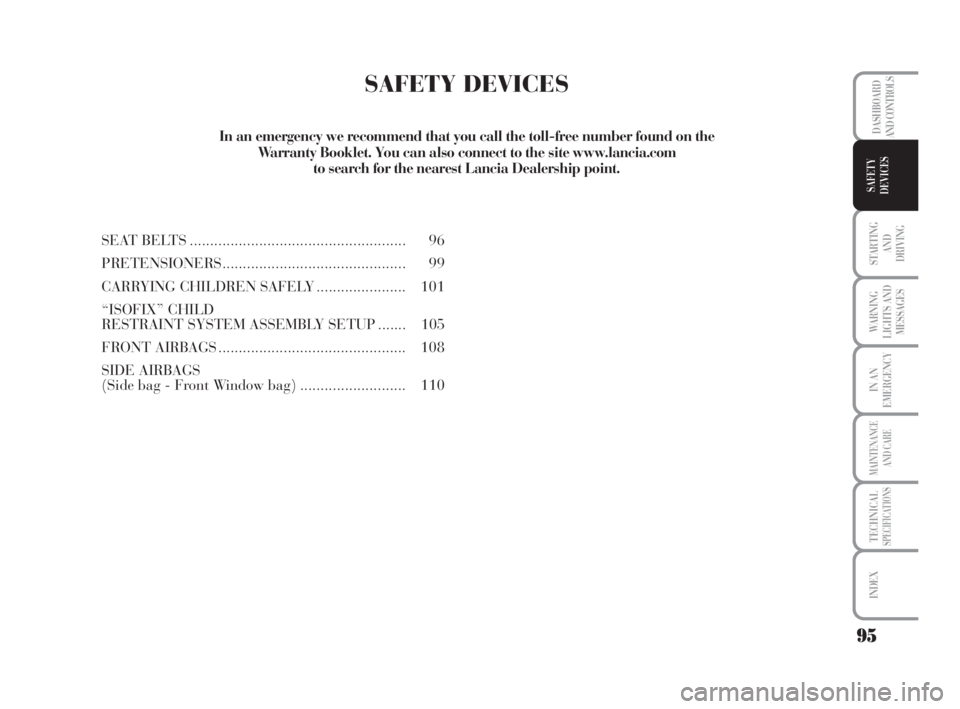
95
STARTING
AND
DRIVING
WARNING
LIGHTS AND
MESSAGES
IN AN
EMERGENCY
MAINTENANCE
AND CARE
TECHNICALSPECIFICATIONS
INDEX
DASHBOARD
AND CONTROLS
SAFETY
DEVICES
SAFETY DEVICES
SEAT BELTS ..................................................... 96
PRETENSIONERS............................................. 99
CARRYING CHILDREN SAFELY ...................... 101
“ISOFIX” CHILD
RESTRAINT SYSTEM ASSEMBLY SETUP ....... 105
FRONT AIRBAGS.............................................. 108
SIDE AIRBAGS
(Side bag - Front Window bag).......................... 110 In an emergency we recommend that you call the toll-free number found on the
Warranty Booklet. You can also connect to the site www.lancia.com
to search for the nearest Lancia Dealership point.
095-112 MUSA 1ed GB 10-07-2008 9:37 Pagina 95
Page 109 of 218

108
STARTING
AND
DRIVING
WARNING
LIGHTS AND
MESSAGES
IN AN
EMERGENCY
MAINTENANCE
AND CARE
TECHNICALSPECIFICATIONS
INDEX
DASHBOARD
AND CONTROLS
SAFETY
DEVICES
FRONT AIRBAGS
The car is supplied with front airbags
for both the driver and passenger, and
window bags (head protection sys-
tem). On driver’s request, it can be
supplied with front side airbags.
The front airbags (for driver and pas-
senger) have been designed to protect
the passengers sitting on the front
seats in the event of head-on crashes
of medium-high severity, by placing
the bag between the person and the
steering wheel or dashboard.
Non-deployment of the airbags dur-
ing other types of collisions (side col-
lisions, rear shunts, roll-overs, etc.)
does not necessarily indicate a system
malfunction.
An electronic control unit causes the
bag to inflate in the event of a frontal
crash. The bag inflates instanta-
neously placing itself between the
front passenger’s body and the struc-
tures which could cause injury. It de-
flates immediately afterwards.
Driver and passenger front airbags are
not a replacement of, but comple-
mentary to the seat belts, which you
are always recommended to wear, as
specified by law in Europe and most
non-European countries.
In the event of a collision, a person
not wearing the seat belt may bethrown forward and come into con-
tact with the bag before it has fully
opened. The protection offered by the
bag is reduced in such a case.
Front airbags may not be activated in
the following situations:
❒during collisions against highly de-
formable objects that do not affect
the car front surface (e.g. bumper
collision against guard rail, heaps
of gravel, etc.);
❒jamming of the car underneath
other vehicles or protective barri-
ers (e.g. underneath a truck or a
guard rail); in this case, the bags
would offer no additional protec-
tion with respect to the seat belt
and their deployment is unneces-
sary. In these cases non-deploy-
ment of the airbag does not neces-
sarily indicate a system malfunc-
tion.
The front airbags on the driver’s and
passenger’s sides are designed and cal-
ibrated to protect the front seat pas-
sengers who wear the safety belts. The
volume of front airbags at max. infla-
tion fills most of the space between
the steering wheel and the driver and
between the dashboard and the pas-
senger.FRONT AIRBAG ON DRIVER’S
SIDE fig. 17
It consists of an instant-inflating bag
contained in a special recess in the
centre of the steering wheel.
fig. 17L0C0416m
095-112 MUSA 1ed GB 10-07-2008 9:37 Pagina 108
Page 111 of 218

110
STARTING
AND
DRIVING
WARNING
LIGHTS AND
MESSAGES
IN AN
EMERGENCY
MAINTENANCE
AND CARE
TECHNICALSPECIFICATIONS
INDEX
DASHBOARD
AND CONTROLS
SAFETY
DEVICES
MANUAL DEACTIVATION OF
FRONT AIRBAG AND SIDE BAG
ON PASSENGER’S SIDE
(where provided)
Whenever a child needs to be carried
on the front seat, the passenger’s front
airbag and the Side Bag (where pro-
vided) must be deactivated.
The warning light “on the instru-
ment panel stays on steadily until the
passenger’s front airbag and the Side
Bag (where provided) are re-acti-
vated.SIDE BAGS
(window bag)
(where provided)
SIDE BAG (where provided) fig.
19
It consists of an instant-inflating bag
housed in the front seat backrest. It
protects the chest of the passengers in
the event of a side crash of medium-
high severity.
To manually deactivate the
passenger’s front airbag and
the Side Bag (where provided), re-
fer to paragraph “Multifunctional
reconfigurable display” in section
“Dashboard and controls”.
WARNING
Do not cover the front seat
backrest with upholstery or
seat covers that hinder deployment
of the side bag.
WARNING
fig. 19L0C0147m
fig. 20L0C0148m
WINDOW BAG
(where provided) fig. 20
It consists of two “drop-down” bags
housed behind the side upholstery of
the roof and covered with finishing el-
ements that protect the head of front
and rear passengers in the event of a
side crash thanks to a wide bag de-
ployment area. Lineaccessori Lancia includes seat
covers enabling side bag deployment.
095-112 MUSA 1ed GB 10-07-2008 9:37 Pagina 110
Page 112 of 218

111
STARTING
AND
DRIVING
WARNING
LIGHTS AND
MESSAGES
IN AN
EMERGENCY
MAINTENANCE
AND CARE
TECHNICALSPECIFICATIONS
INDEX
DASHBOARD
AND CONTROLS
SAFETY
DEVICES
Side bags are not a replacement of,
but complementary to the seat belts,
which you are always recommended
to wear, as specified by law in Europe
and in most non-European countries.
IMPORTANT In the event of a side
crash, the system provides best pro-
tection if the passenger sits on the seat
in a correct position, thus allowing
correct window bag deployment.
IMPORTANT The front airbags
and/or side bags are deployed also if
the car is subject to strong collisions
or accidents involving the underbody
area, such as violent shocks against
steps, kerbs or low obstacles, falling
of the car in big holes or sags in the
road.
IMPORTANT A small amount of dust
is released when the airbags are de-
ployed. The dust is not harmful and
does not indicate the beginning of a
fire. Furthermore, the surface of the
deployed bag and the interior of the
car may be covered with residual
dust. This dust may irritate the skin
and the eyes. Use mild soap and wa-
ter to wash the parts of your body ex-
posed to this dust.The pyrotechnic charge of the airbag
system lasts for 14 years; the spiral
contact 10 years. Go to a Lancia
Dealership to have the devices re-
placed when the expiration date ap-
proaches.
IMPORTANT Should an accident oc-
cur activating any of the safety de-
vices, take the car to a Lancia Deal-
ership to have the activated devices
replaced and the system checked.
Airbag checking, repair and replace-
ment must only be carried out c/o the
Lancia Dealership.
If you are having the car scrapped,
have the airbag system deactivated at
a Lancia Dealership first. If the car
changes ownership, the new owner
must be informed of how to use the
airbags and the above warnings: s/he
must also be given this “Owner’s
Handbook”.
IMPORTANT Pretensioners, front
airbags and front side bags are de-
ployed differently according to the
type of collision. Non-deployment of
one of the devices does not necessar-
ily indicate a system malfunction.
Do not rest the head, arms
or elbows on the door, win-
dows and window bag area to avoid
possible injuries during inflation.
Never lean head, arms and elbows
out of the window.
WARNING
If the warning light ¬does
not turn on or stays on dur-
ing car travel when turning the key
to MAR, a failure may be present in
the restraint systems. If this is the
case, the airbags or pretensioners
may not be deployed after an impact
or, in a minor number of cases, they
may be deployed accidentally. Con-
tact a Lancia Dealership immedi-
ately to have the system checked.
Do not cover the front seat backrest
with upholstery or seat covers that
hinder deployment of the side bag.
WARNING
GENERAL WARNINGS
095-112 MUSA 1ed GB 10-07-2008 9:37 Pagina 111
Page 119 of 218
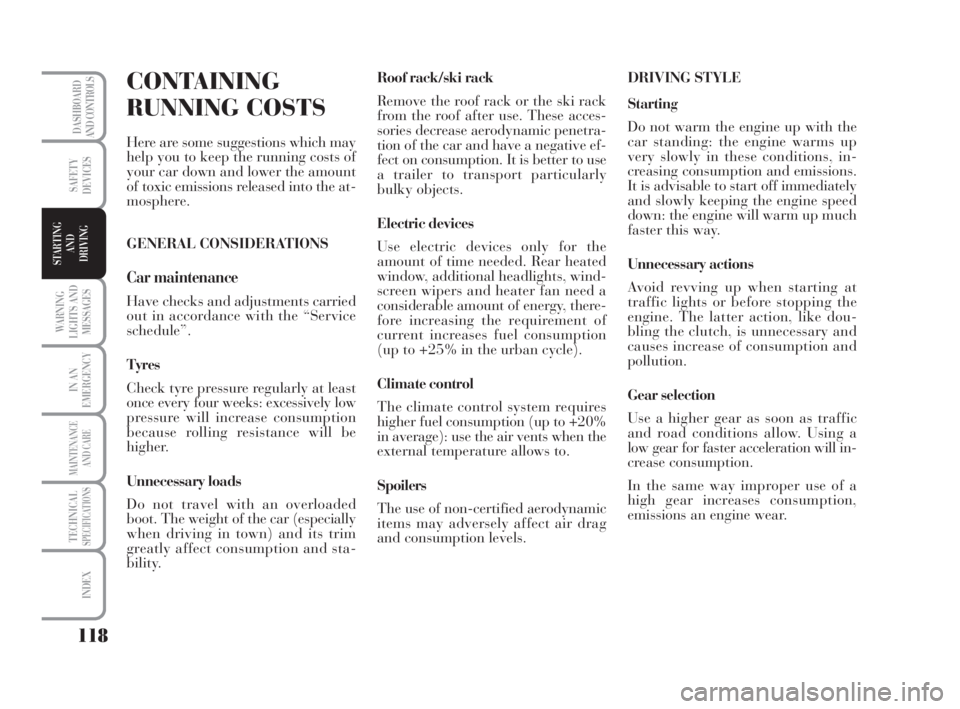
118
WARNING
LIGHTS AND
MESSAGES
IN AN
EMERGENCY
MAINTENANCE
AND CARE
TECHNICALSPECIFICATIONS
INDEX
DASHBOARD
AND CONTROLS
SAFETY
DEVICES
STARTING
AND
DRIVING
CONTAINING
RUNNING COSTS
Here are some suggestions which may
help you to keep the running costs of
your car down and lower the amount
of toxic emissions released into the at-
mosphere.
GENERAL CONSIDERATIONS
Car maintenance
Have checks and adjustments carried
out in accordance with the “Service
schedule”.
Tyres
Check tyre pressure regularly at least
once every four weeks: excessively low
pressure will increase consumption
because rolling resistance will be
higher.
Unnecessary loads
Do not travel with an overloaded
boot. The weight of the car (especially
when driving in town) and its trim
greatly affect consumption and sta-
bility.Roof rack/ski rack
Remove the roof rack or the ski rack
from the roof after use. These acces-
sories decrease aerodynamic penetra-
tion of the car and have a negative ef-
fect on consumption. It is better to use
a trailer to transport particularly
bulky objects.
Electric devices
Use electric devices only for the
amount of time needed. Rear heated
window, additional headlights, wind-
screen wipers and heater fan need a
considerable amount of energy, there-
fore increasing the requirement of
current increases fuel consumption
(up to +25% in the urban cycle).
Climate control
The climate control system requires
higher fuel consumption (up to +20%
in average): use the air vents when the
external temperature allows to.
Spoilers
The use of non-certified aerodynamic
items may adversely affect air drag
and consumption levels.DRIVING STYLE
Starting
Do not warm the engine up with the
car standing: the engine warms up
very slowly in these conditions, in-
creasing consumption and emissions.
It is advisable to start off immediately
and slowly keeping the engine speed
down: the engine will warm up much
faster this way.
Unnecessary actions
Avoid revving up when starting at
traffic lights or before stopping the
engine. The latter action, like dou-
bling the clutch, is unnecessary and
causes increase of consumption and
pollution.
Gear selection
Use a higher gear as soon as traffic
and road conditions allow. Using a
low gear for faster acceleration will in-
crease consumption.
In the same way improper use of a
high gear increases consumption,
emissions an engine wear.
113-124 MUSA 1ed GB 10-07-2008 9:37 Pagina 118
Page 125 of 218
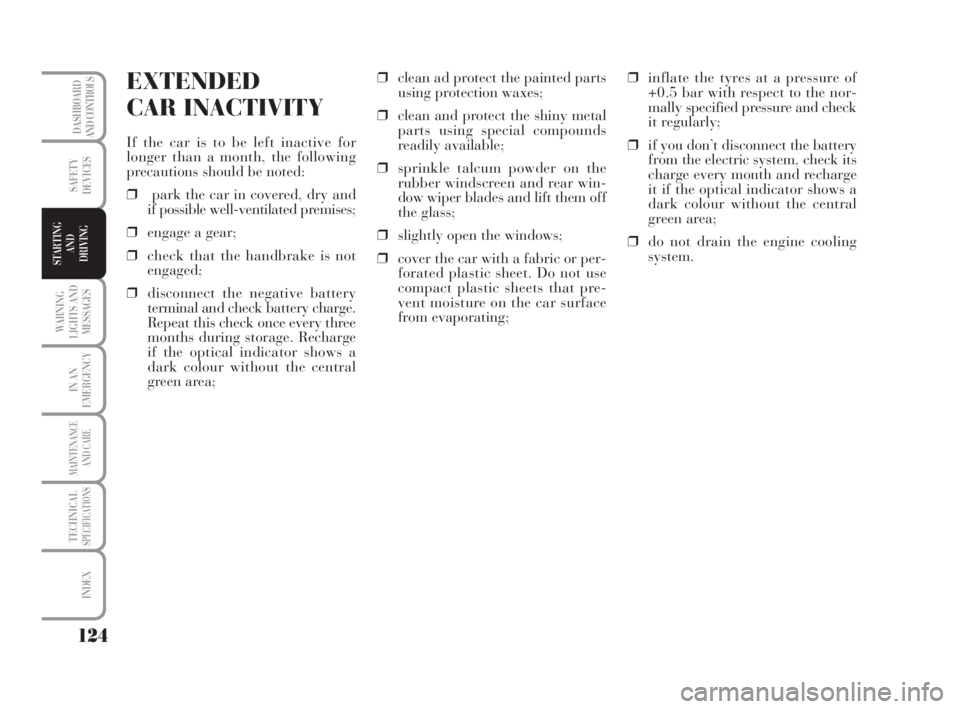
124
WARNING
LIGHTS AND
MESSAGES
IN AN
EMERGENCY
MAINTENANCE
AND CARE
TECHNICALSPECIFICATIONS
INDEX
DASHBOARD
AND CONTROLS
SAFETY
DEVICES
STARTING
AND
DRIVING
EXTENDED
CAR INACTIVITY
If the car is to be left inactive for
longer than a month, the following
precautions should be noted:
❒park the car in covered, dry and
if possible well-ventilated premises;
❒engage a gear;
❒check that the handbrake is not
engaged;
❒disconnect the negative battery
terminal and check battery charge.
Repeat this check once every three
months during storage. Recharge
if the optical indicator shows a
dark colour without the central
green area;❒clean ad protect the painted parts
using protection waxes;
❒clean and protect the shiny metal
parts using special compounds
readily available;
❒sprinkle talcum powder on the
rubber windscreen and rear win-
dow wiper blades and lift them off
the glass;
❒slightly open the windows;
❒cover the car with a fabric or per-
forated plastic sheet. Do not use
compact plastic sheets that pre-
vent moisture on the car surface
from evaporating;❒inflate the tyres at a pressure of
+0.5 bar with respect to the nor-
mally specified pressure and check
it regularly;
❒if you don’t disconnect the battery
from the electric system, check its
charge every month and recharge
it if the optical indicator shows a
dark colour without the central
green area;
❒do not drain the engine cooling
system.
113-124 MUSA 1ed GB 10-07-2008 9:37 Pagina 124
Page 160 of 218
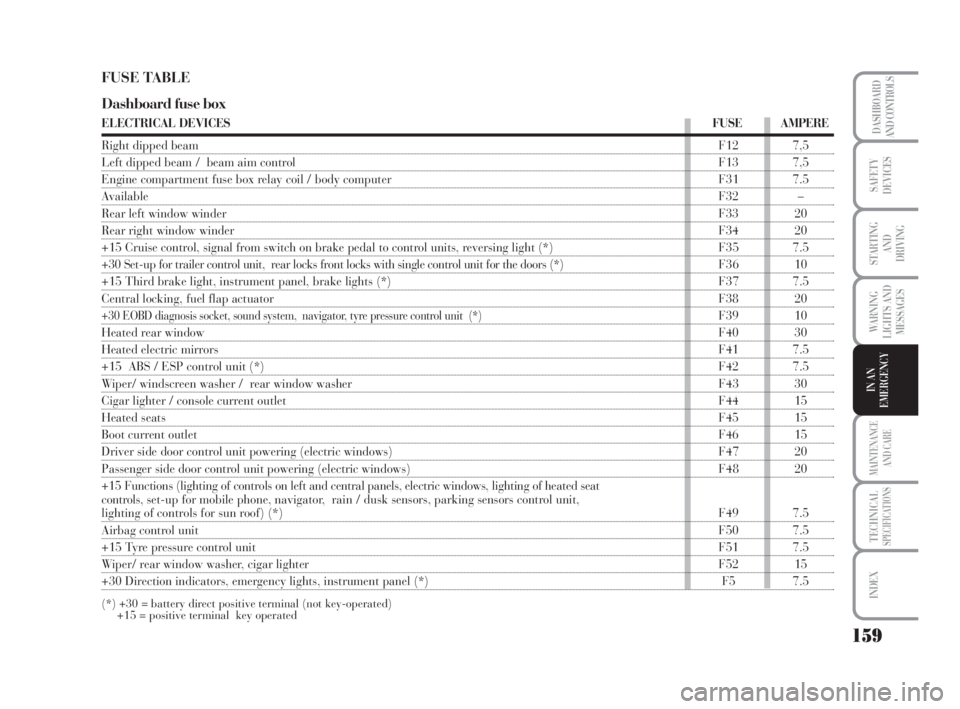
159
WARNING
LIGHTS AND
MESSAGES
MAINTENANCE
AND CARE
TECHNICALSPECIFICATIONS
INDEX
DASHBOARD
AND CONTROLS
SAFETY
DEVICES
STARTING
AND
DRIVING
IN AN
EMERGENCY
FUSE TABLE
Dashboard fuse box
ELECTRICAL DEVICESFUSE AMPERE
Right dipped beam F12 7,5
Left dipped beam / beam aim controlF13 7,5
Engine compartment fuse box relay coil / body computer F31 7.5
AvailableF32 –
Rear left window winderF33 20
Rear right window winderF34 20
+15 Cruise control, signal from switch on brake pedal to control units, reversing light (*) F35 7.5
+30 Set-up for trailer control unit, rear locks front locks with single control unit for the doors (*) F36 10
+15 Third brake light, instrument panel, brake lights (*) F37 7.5
Central locking, fuel flap actuatorF38 20
+30 EOBD diagnosis socket, sound system, navigator, tyre pressure control unit (*)F39 10
Heated rear window F40 30
Heated electric mirrors F41 7.5
+15 ABS / ESP control unit (*)F42 7.5
Wiper/ windscreen washer / rear window washer F43 30
Cigar lighter / console current outletF44 15
Heated seats F45 15
Boot current outletF46 15
Driver side door control unit powering (electric windows) F47 20
Passenger side door control unit powering (electric windows) F48 20
+15 Functions (lighting of controls on left and central panels, electric windows, lighting of heated seat
controls,set-up for mobile phone, navigator, rain / dusk sensors, parking sensors control unit,
lighting of controls for sun roof) (*)F49 7.5
Airbag control unit F50 7.5
+15 Tyre pressure control unitF51 7.5
Wiper/ rear window washer, cigar lighter F52 15
+30 Direction indicators, emergency lights, instrument panel (*) F5 7.5
(*) +30 = battery direct positive terminal (not key-operated)
+15 = positive terminal key operated
135-164 MUSA 1ed GB 10-07-2008 9:38 Pagina 159